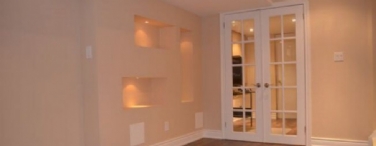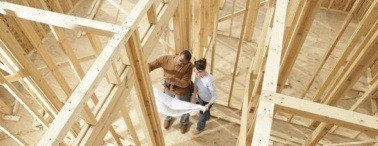
Excerpt The following is an excerpt from the book Invest in Your Nest by Barbara Kavovit
Published by Rodale; June 2006;$19.95US/$26.95CAN; 1-59486-151-X Copyright © 2006 Barbara Kavovit
Grow the Space You Have
Transforming existing raw space into an extra bedroom, a playroom, or a guest or master suite is an affordable way to make your house bigger. You can also winterize an unheated sunroom or porch to transform a two- or three-season room into a year-round retreat. You can transform a two-bedroom, two-bath house into a "new" three-bedroom, three-bathroom house just by making your unused space livable!
Be Your Own Project Manager
Finishing the existing raw space in your home for livability requires the help of specialists in several trades: plumbing, carpentry, electrical, and others, including flooring and possibly stoneworking for tile work. So while it's not a do-it-yourself job, you can manage the project yourself and become your own general contractor. That way, you'll save money and choose and work with the tradespeople whom you really like. Managing the project gives you tremendous control over personnel, quality control, and finishes. You're the boss! Here are the basic steps you'll want to follow:
Set aside some time

Expect to spend from 1 to several hours a day for several months dealing with some aspect of the renovation. Managing the transformation of any space in your home does not require you to be on-site every minute, but you do have to check in often, inspect the work as it progresses, pay bills, consult with the tradespeople who are on the site, coordinate with and schedule the tradespeople who need to come in, make sure the site is organized safely and in a way that protects workers (and therefore your liability), monitor rubbish removal, and troubleshoot.
Determine your budget

Every decision you make flows from your budget, from how much to spend on flooring to how fancy you want your bathroom fixtures to be.
Decide how you want to use the space

Will it be an extra bedroom and bath, a family room, or a children's playroom? The function will help inform many of the finishes you choose. For example, a children's playroom may benefit from a hardwood floor partially covered by a large rug. How elaborate do you want the bathroom to be? If you are transforming a space into a master suite, the bathroom should have double vanities and a glass enclosure for the shower, which should have extra wall and overhead showerheads.
Gather the right professionals

Several professionals are involved in an addition project. They include:
Architect

Carpenter and/or drywall contractor

Flooring contractor

Licensed electrician

HVAC specialist

Licensed plumber

Window supplier/installer
As project manager, you coordinate the work, schedule, and budget. Jobs need to be completed in a particular order. Follow this general timeline:
Prepare the floor

Check the condition of the existing subfloor and floor joists. If you are finishing a basement, you must inspect the condition of its floor. Most basements have poured concrete floors, and sometimes they slope steeply for drainage purposes. If that's the case, the floor must be leveled before proceeding with the work. A handyperson or contractor should pour a thin concrete overlay to level it. Be sure that access to any existing floor drains is maintained! Drains need to stay functional in case of basement flooding. Check with a plumber to find out if you will be required to periodically pour water in them to prevent sewer gas from building up.
Install any necessary HVAC systems

Ductwork is cumbersome. In basements, where ceiling height is always a consideration, soffits may be required to cover up any vents running overhead, which can lower the ceiling. Basements are usually cool and may not require air-conditioning systems. They do require heating, however. Be sure the HVAC specialist locates supply ducts near outside walls. Install return air ducts on interior walls or ceilings away from the supply ducts. The idea is to "draw" air across the room. Particular attention must be paid to ventilating, heating, and cooling attic rooms.
Install plumbing

You can solve plumbing issues in other parts of your house at this time, too, if necessary. If the existing drain stacks in the house are made from PVC, they need to be wrapped with insulation to minimize sound transmission. Cold-water lines may need to be insulated if you have had problems in the past with condensation, because it may drip onto your new ceiling. Have the plumber rough in bathroom plumbing so he or she can come back later to install the fixtures. Rough plumbing is all the plumbing components that need to be installed before the finish tradespeople (drywall contractor, painter, and so on) come in to do their jobs, including the waste and supply water lines that are in the walls or framing of the building. Ask the plumber to use ½-inch or 1-inch lines instead of the more common ¼-inch lines in the bathroom for extra water pressure.
Have necessary electrical work done

All electrical work must be done in compliance with the National Electrical Code or the code adopted by your community. Don't skimp on the electrical system. Make a list of everything you intend to use in the room (appliances, light fixtures, electronic equipment, and so on) so the electrician can calculate the required load and make sure you have enough circuits. He or she can rough in wiring for ceiling fixtures at this time and come back to install the fixtures when the drywall or drop ceiling has been installed. Think ahead. Make sure you can access the main electrical service panel and telephone and cable TV termination points. Ask the electrician to install conduits through which additional wires can be run at a later date. Don't forget about wiring the space for surround sound.
Install cable and phone lines

Call your service companies and schedule a time for them to add new telephone, data, and cable wiring. Be sure to have them add extra phone and data lines now, even if you don't plan on using them all right away. Adding them later on is more expensive.
Build and insulate the walls

A carpenter can install 2 x 4-inch studs if they aren't already there, as well as a variety of thermal insulation materials, from traditional soft batting to rigid foil-faced sheets to blown-in insulation. He or she should be able to advise you on what is recommended for your geographic region and application.
Install walls

You can choose one of several types of wallboard or paneling. I prefer drywall because it gives you the most flexibility and doesn't scream "finished basement" the way paneling does. Plus, you can always apply bead-board wainscoting, faux finishes, wallpaper, or other treatments over drywall at a later date.
Install the ceiling

I prefer drywall ceilings, but I admit that the ubiquitous and industrial-looking acoustical tile or drop ceiling has come a long way. It now comes in a variety of styles, from bead board to decorative embossed styles that look like old-fashioned tin ceilings. The advantages of installing a drop ceiling are that it creates an accessible tray for ductwork and wiring and if one tile gets damaged, it's easy to replace (buy 10 percent more than you need for coverage). The disadvantages are that it lowers the ceiling height, which might be at a premium in your attic or basement. For drywall ceiling, the drywall contractor or carpenter builds soffits around any ductwork. That means that making a drywall ceiling takes extra work and is therefore somewhat more expensive than a drop ceiling, but the ceiling will be lower only in the areas where ductwork exists and headroom is maximized everywhere else.
Install the floor

I love hardwood, as you know. If you happen to be finishing a basement-level room, however, think twice before choosing hardwood flooring. Hardwood flooring trade associations and manufacturers caution against using traditional hardwood below ground level, even in very dry basements. Instead, consider engineered hardwood click flooring, laminates, tile, or carpeting. If you are worried about wet floors or insect infestation, install treated or marine plywood as a subfloor before proceeding with the final finish.
Install final fixtures

Have the plumber and electrician return to install the permanent bathroom and electrical fixtures.
Paint trim and walls
Furnish your new rooms and enjoy them!
Reprinted from: Invest in Your Nest: Add Style, Comfort, and Value to Your Home by Barbara Kavovit © 2006 Rodale Inc. Permission granted by Rodale, Inc., Emmaus, PA 18098. Available wherever books are sold or directly from the publisher by calling (800) 848-4735 or visit their website at www.rodalestore.com.
Click here to purchase a copy of Invest in Your Nest
Author

Barbara K is CEO of barbara k!, a comprehensive lifestyle brand that offers solutions for women through innovative home enhancement/repair and automotive products. She is also the home improvement expert for AOL Coaches and author of the inspirational fix-it handbook Room for Improvement. Barbara has been featured in the New York Times, USA Today, Real Simple, and O, The Oprah Magazine, among others, and has appeared on numerous television and radio programs, including Today and Good Morning America. She lives in New York City with her son, Zachary. For Barbara K's products, visit www.barbarak.com
NOTE:
TrustedPros.ca does not indorse any products or sites but includes them as a source of information. HandyCanadian.com does not claim to be a certified professional organization nor do we claim to employ certified professionals in any home repair or improvement field. All information on this site is provided for informational and educational purposes only. We are not responsible for what you do with the information. Please consult a professional before beginning major home renovation or improvement work.
Posted by: TrustedPros





